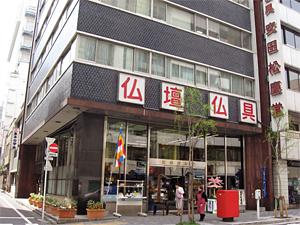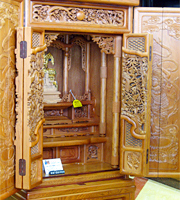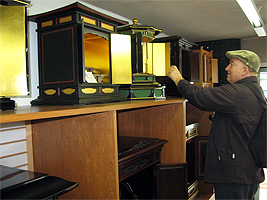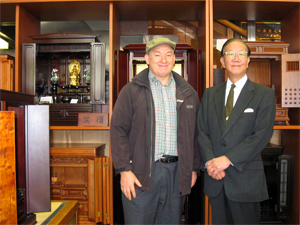 |
セインさん、今日うかがうのは銀座にある仏壇屋さん「安田松慶堂」です。寛政4年(1792)の創業で、初代は近江(現在の滋賀県)の方。徳川将軍家に招かれて、江戸・日本橋に来られたそうですよ。さあ、お店に入りましょう。
Thayne-san, today we’ll be visiting a shop in Ginza called Yasuda Shokeido which sells family Buddhist altars. It was founded in the fourth year of the Kansei Period (1792), and the first generation owner was from Omi (present-day Saga Prefecture). Apparently the Tokugawa Shogunate asked them to come to Nihonbashi in Edo. Well, let’s go in. |
|
|
|
 |
|
銀座7丁目にある本店。新橋演舞場がすぐそこ
The shop front in Ginza 7-chome, nearby Shimbashi Theater. |
|
|
| (安田) |
ようこそ、セインさん。安田松慶です。
Thayne-san, welcome! I’m Yasuda Shokei. |
|
|
 |
こんにちは、安田さん、セインです。本日はよろしくお願いします。安田さんは、お店の名前と同じ「松慶」というお名前なんですね。
Hi, Yasuda-san, I’m Thayne. Thanks for having us. You have the same name as your shop, don’t you? |
|
|
| (安田) |
はい。初代が鎌倉時代の有名な彫刻師・運慶の流れを汲んでいたことから、3代目までは運慶の一字を取って「元慶」と名乗っていましたが、4代目からは「松慶」の名を世襲して、私が7世となります。
That’s right. Our first generation followed the famous sculptor Unkei in the Kamakura Period, and, borrowing the second Chinese character of his name, our shop was called Genkei until the third generation. Starting with the fourth generation, we took the name Shokei, and I’m the seventh generation. |
|
|
 |
新橋演舞場のすぐ近くにお店があるんですね。驚きました。
I was surprised to find out the shop was so close to Shimbashi Theater. |
|
|
| (安田) |
日本橋からこちらに移転して、40年程になります。当時、このあたりは新橋の花街が隆盛を極めていて、芸者置屋や料亭が軒を連ねていました。そこに仏壇屋が来たものですから、新橋の芸者さんたちが「ここじゃ商売にならないから、すぐにつぶれるんじゃないの」と噂したそうです。でも、なかなかがんばっているでしょ(笑)?
It’s been about 40 years since we moved here from Nihonbashi. At the time, this area was the booming red-light district of Shimbashi, full of geisha houses and first-class restaurants (ryotei). That’s the kind of environment we, a Buddhist altar shop, moved into, and apparently the geisha of Shimbashi gossiped amongst themselves that we would go under for lack of business. I think we’re doing quite well though, no? |
|
|
 |
はい(笑)。 それにしても、お店の中は仏壇だらけですね。当たり前のことですが。
Certainly. Your shop is absolutely full of altars. I guess that only makes sense. |
|
|
| (安田) |
今日は、心ゆくまで仏壇をご覧になって、お気に入りのものがございましたら、一つ二つ、お買い求めください(笑)。
Please take your time today looking at our selection of altars―and if you see one or two you like, please let me know! |
|
|
 |
よく見かける黒い仏壇だけじゃなくて、木目を生かして彫刻をほどこした工芸品のような仏壇もあれば、ドレッサーか飾り棚のようなしゃれたものまで、本当にいろいろな種類があるんですね。
In addition to the black altars you often see, you have carved altars showing the wood grain, like works of art, and fancy altars that look like vanities or ornamental shelves. There are so many varieties. |
|
|
| (安田) |
最近は、家具調の仏壇がよく売れています。
These days altars fashioned to look like cabinets are selling well. |
|
|
|
 |
|
屋久杉製の仏壇。扉のレリーフなど、随所に職人技が光る
An altar made from Yakushima cedar. The skill of the artisans really stands out in several places, such as the relief of the doors. |
|
 |
|
黒檀・紫檀・桑などの銘木でつくる東京仏壇を中心に、家具調仏壇もいろいろ。家具調仏壇は色も形も、扉を開けなければ仏壇とはわからないようなモダンなものが数多く取り揃えられている。
Tokyo-style altars built to look like cabinets are often made from nice woods such as ebony, rosewood, or mulberry, and come in many different shapes and colors. They also have many modern-looking ones that don’t look like altars at all until you open the doors. |
|
|
 |
こうしてあらためて一つ一つ見ていると、仏壇というのはきれいなものですね。
As I take a close look at each of these altars, I find myself fascinated by their beauty. |
|
|
| (安田) |
ええ。普通、仏壇に向かい合う時は、亡くなった人のことを考えていますから、仏壇そのものをじっくりご覧になることは少ないと思いますが、仏壇には、日本の職人仕事の粋が集められているんです。
Usually when we face a family altar, we are thinking about those who have passed away, and the time spent looking closely at the altar itself is short. Nevertheless, the skill of Japan’s artisans has gone into making them. |
|
|
 |
全部手作りなんですか?
Are they all made by hand? |
|
|
| (安田) |
はい。彫刻、漆塗り、金箔貼り……と、1つの仏壇に様々な職人の技が駆使されています。弊社も埼玉の工場に17人の宮大工を抱えていますが、仏壇のほかに寺院の荘厳仏具も作っていますし、本堂などの建築も行っています。芝の増上寺や成田山新勝寺の荘厳仏具も手掛けていますので、今度、行かれたら、ぜひじっくりご覧ください。
Yes. Each altar requires several steps done by skilled artisans, including the carving, lacquering, and adding of the gold leaf. At a workshop in Saitama our company employs 17 carpenters who specialize in temple architecture and construction, and in addition to family altars, they make adorning features of temples as well. Our artisans have also worked on Zojoji in Shiba, Tokyo, and Naritasan Shinshoji Temple, so the next time you visit, please take a close look. |
|
|
 |
荘厳仏具というのは仏様の周りや天井を飾っている金属製のきらきら輝いている装飾のことですか?
By adorning features, do you mean the shiny metallic decorations hanging from the top? |
|
|
| (安田) |
はい。でも、セインさん。あれも金属製じゃないんですよ。今、ご説明したように、木を削って形作り、漆を塗り、金箔を貼った部品を作り、それを組み合わせているんです。荘厳仏具も、寺院建築も、鉄釘は1本も使わずに作るんですよ。
That’s right, but those aren’t metal. As I was saying, the wood is carved into the right shape, lacquer is painted on, the pieces with gold leaf are made, and everything is put together. Construction of both temples and altar articles is done without using a single metal nail. |
|
|
 |
なぜ鉄釘を使わないのですか。その方が、ずっと丈夫だと思うんですが。
Why don’t you use metal nails? I would think it would be stronger that way. |
|
|
| (安田) |
いえいえ、木の方がずっと丈夫なんです。奈良や京都に行くと、何百年も前に建てられた木造建築物がたくさんあるでしょう? 木は一見、弱そうですが強いんです。そして、彫刻や金箔などの工芸によって、金属以上に長い時間、豪華に見せることができるんです。
Not at all―wood is actually much stronger. Nara and Kyoto have many wooden buildings built hundreds of years ago, right? On the surface, wood seems less strong, but actually, the opposite is true. By carving the pieces and using gold leaf, their brilliance lasts much longer than if the pieces were metal. |
|
|
 |
なるほど。それにしても、日本のお寺にしても西洋の教会にしても、人はなぜ立派な寺院を建て、豪華に飾りたてるんでしょうか。
Is that right? I have to wonder why is it that people build magnificent, lavishly decorated temples, be it Japanese temples or Western churches. |
|
|
| (安田) |
昔、仏教が盛んになり始めた頃、その建物の大きさや金色に輝く装飾の豪華さで人々を圧倒する、ということだと思います。恐れおののかせるといいますか、その荘厳さにひれ伏さずにはいられないような気持ちにさせる。そのパワーが、信仰心に繋がっていく、ということだと思います。
I think it’s because in the old days, when Buddhism was just beginning to spread in Japan, people were greatly impressed by the size of the buildings and the splendor of the sparkling gold. They felt in awe―they felt the need to prostrate themselves before such majesty. This feeling led to religious belief. |
|
|
 |
なるほど。
I see. |
|
|
| (安田) |
ただ、日本の仏教はもともと、神仏への信仰心とは別に、祖先崇拝が根底にあります。つまり神がいて自分がある、のではなく、祖先があって自分がある、という考え方が基本にあるんです。仏壇は、その先祖崇拝をするための、最も身近な祭壇です。
Separate from a belief in gods and the Buddha, ancestor worship has been an integral part of Buddhism in Japan from the beginning. It’s not “there was God and here I am,” but rather “there are my ancestors and here I am.” The family altar is the closest way for people to show their devotion. |
|
|
 |
先祖崇拝の考え方は、キリスト教にはない。だから、仏壇のようなものも家にはないんですね。
The concept of ancestor worship doesn’t exist in Christianity, which is why Christians don’t have family altars in their homes. |
|
|
| (永井) |
はい。でも、日本も変わってきました。マンションなどは和室がないタイプが一般的ですし、戸建ての家でも床の間を作らない家が多い。お寺との付き合い方も減っています。江戸時代には、子どもが生まれるとお坊さんが名前を付けたりしましたし、庶民の生死、戸籍を把握していました。また生活の指導的な役割を果たしてもいましたが、今はそういうことが少なくなっているように思います。
Right. But things have changed in Japan. Most high-rise apartment buildings don’t have Japanese-style tatami rooms, and even single-family homes often don’t have a tokonoma. People’s relationships with temples have also diminished. In the Edo Period, Buddhist monks would name a child when she or he was born, and they dealt with matters of birth and death, and kept the official family registries. They played a leading role in people’s lives. These days however I think those kinds of things have become much less common. |
|
|
 |
でも、最近は、心を鎮めに、社寺に行く人が増えているようです。今後、日本人の宗教観は変わっていくかもしれませんね。
But I hear that recently the number of people visiting temples and shrines to find peace and tranquility has been growing. Japanese views on religion may change yet again. |
|
|
| (安田) |
最近、「生前準備」とか「終活」とか言って、死ぬ前に財産分与とか葬式の在り方などを書き残す方が増えているのをご存じですか?
More and more people are leaving instructions for their funeral or the distribution of their property before they leave, have you heard? |
|
|
 |
はい、ちょっとしたブームになっていますね。
Yes, that’s become quite popular, hasn’t it? |
|
|
| (安田) |
その『終活ノート』を見ると、「葬式は親族だけで質素に執するように」などと書いてあって、そのとおりにするご家族が多いんですが、これは残った家族にできるだけ迷惑をかけないようにしたいという遠慮から書いているんですね。 ですが、1人の人間が60年、70年、80年と、立派に生きたんです。たくさんの人と出会い、つき合って、苦労もしたし、幸せも得た。がんばって生きた。その人が亡くなったというのに、友達にもほとんど声をかけずに葬式を行って墓に入れてしまうなんて、それはないんじゃないでしょうか。できる範囲で、大勢の人々に集まっていただき、故人の功績を偲んで葬式をして送り出してあげるべきだと私は思うんです。
If you look at these instructions, you can see that some people want a simple funeral attended only by their relatives, and many families follow their instructions exactly. However, those kinds of instructions are written out of modesty; they don’t want to cause their families any more trouble than necessary. But people who have lived for 60, 70, or 80 years have met all kinds of people, made lots of friends, struggled together with many of them, and found happiness. They’ve lived a splendid life. To hold a funeral without telling the friends seems really sad. I think to the extent possible, funerals should be a time when lots of people gather to remember the deceased and their achievements, and give them a farewell. |
|
|
  |
なるほど。ほんとうにそうですね。 今日はいいお話をうかがいました。ありがとうございました。
I think you’re absolutely right. We really learned a lot today from you. Thank you so much for talking with us. |
|
 |
|
(文)太田美代 (英訳)デイビッド・A・セイン |
 1959年、米国生まれ。証券会社勤務を経て来日し、翻訳・通訳など多岐にわたって活躍。豊富な教授経験を生かし、数多くの英語関係書籍を執筆。近著に『日本人のチョットへんな英語』(アスコム)、『超入門シャドーイング』(主婦の友社)、日本人が使いすぎる英語(PHP文庫)など多数。
1959年、米国生まれ。証券会社勤務を経て来日し、翻訳・通訳など多岐にわたって活躍。豊富な教授経験を生かし、数多くの英語関係書籍を執筆。近著に『日本人のチョットへんな英語』(アスコム)、『超入門シャドーイング』(主婦の友社)、日本人が使いすぎる英語(PHP文庫)など多数。










